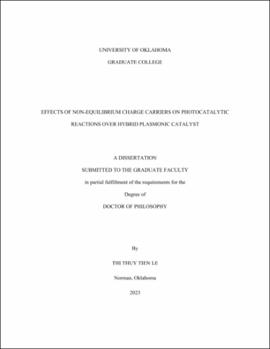| dc.description.abstract | Fascinated by how nature can directly transfer solar energy into a chemical reaction, several studies on the photocatalyst have been performed and hoped to imitate nature’s process to achieve similar conversion. Unfortunately, the ultralow efficiencies of the photocatalyst largely remained. Plasmonic catalyst based on the local surface plasmon resonance of noble metal nanoparticles is then investigated to increase the utilization of the visible wavelength and tailor the reaction selectivity toward a more sustainable future. Particularly, the hybrid plasmonic catalyst between noble metal and other components received a lot of interest due to the prolonged lifetime of the charge carriers or the number of chemical reactions that can be activated. However, on the hybrid plasmonic photocatalyst, the mechanism of how non-equilibrium charge carriers induce reactions remains unclear, especially under the solvent effect. In this dissertation, it is attempted to give an understanding of how non-equilibrium electrons can facilitate reactions on the plasmonic hybrid of copper (I) oxide, a promising oxide in photocatalysis using visible light, and of zeolite, a unique micro porous oxide that has several applications in the energy and fuel field. While the former type, the hybrid between plasmonic nanoparticle and the semiconductor, is expected to extend the lifetime of charge carriers, the latter type is applicable to various reactions.
Using CO2 conversion as the probe, we found that the non-equilibrium carriers do not change much the intrinsic activation energy of CO2 dissociation on a Cu2O pristine surface at the excited states compared to the ground state. In contrast, if the oxygen vacancies are introduced, the intrinsic barrier could be reduced at the ground state, and this remaining barrier could be further eliminated at the excited states because of the non-equilibrium electrons. The regeneration of oxygen vacancies is feasible via the hydrogenation process with low required energy and is not affected by the presence of the non-equilibrium charge carriers.
For the hybrid catalyst between a plasmonic metal and zeolite, it is revealed that the non-equilibrium charge carriers can alter the interaction between ammonia and the Lewis acid site of Beta zeolite. The effect is more significant when there are mid-gap states induced Sn or Ti doped into Si-BEA framework. Apart from the effect on the heat adsorption, it is found that if the doped concentration of Ti into zeolite increases, the intrinsic activation energy of the propylene epoxidation also can be reduced due to the higher population of the non-equilibrium electrons to induce reactions. These studies provide the opportunity to use highly energetic charge carriers, generated in plasmonic metal, to tune the zeolite activity for acid-catalyzed reactions.
Finally, we explored the effect of solvent on the excitation energy and found that the H-bond between solvents and reactants could interfere with the interfacial charge transfer process. Notably, the H-bond between solvent and ammonia can prohibit the excitation energy to trigger an electron from the Fermi level to LUMO of ammonia. At the same time, it can reduce the excitation energy to excite an electron from molecular HOMO to the Fermi level. The stronger acidity of the solvent, the more inhibition effect is observed for the transfer of electrons from the Fermi level to LUMO. In addition, we found that the H-bond also affects the HOMO-LUMO gap of the molecules, which directly influences the energy transfer between plasmonic metal and reactants. The findings of this dissertation could be a valuable guideline for hybrid plasmonic catalyst design for sustainable energy and chemical production. | en_US |
